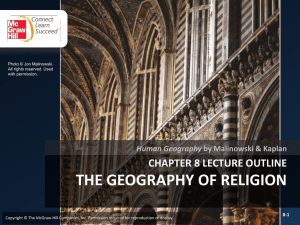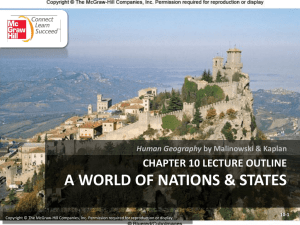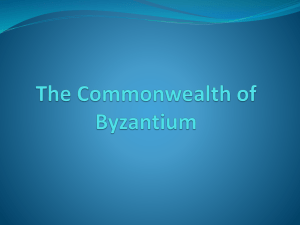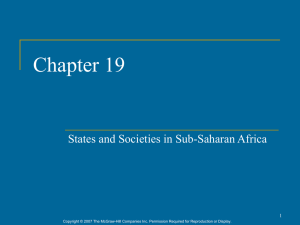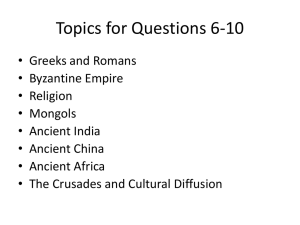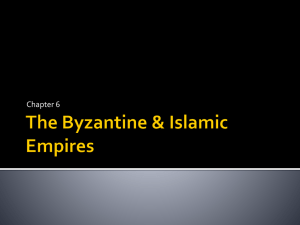13_Bentley3
advertisement
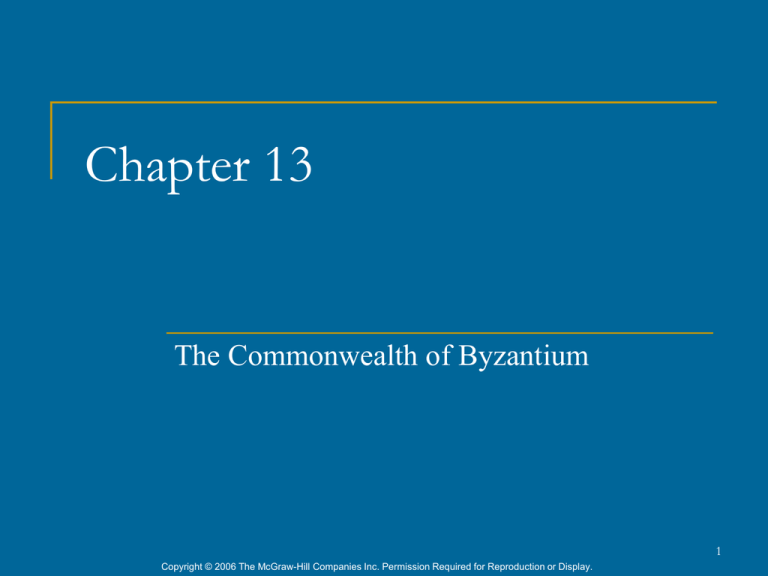
Chapter 13 The Commonwealth of Byzantium 1 Copyright © 2006 The McGraw-Hill Companies Inc. Permission Required for Reproduction or Display. The Early Byzantine Empire Capital: Byzantium On the Bosporus Commercial, strategic location (East meets West) Constantine names capital after himself (Constantinople), moves capital there 340 CE 1453 falls to Turks, renamed Istanbul 2 Copyright © 2006 The McGraw-Hill Companies Inc. Permission Required for Reproduction or Display. The Later Roman Empire and Byzantium Byzantine Empire inherits Roman Empire after fall of Rome in 5th c. CE Eastern territories remain a major hemispheric power until 13th c. CE 3 Copyright © 2006 The McGraw-Hill Companies Inc. Permission Required for Reproduction or Display. The Later Roman Empire Roman infrastructure remains in place in the East Roads, institutional hierarchies, communication networks State in the East is much different than western Roman Empire Challenges from strong Persian empire (Sassanid dynasty, 226-641 CE) Invasions of Germanic peoples from the north 4 Copyright © 2006 The McGraw-Hill Companies Inc. Permission Required for Reproduction or Display. Caesaropapism Power centralized in figure of Emperor Christian leader cannot claim divinity, rather claims divine authority Political rule and Religious rule No separation of church and state Absolute Authority-- Emperors have final say in all matters Byzantine: Unnecessary complexity & convolution ----large bureaucracy 5 Copyright © 2006 The McGraw-Hill Companies Inc. Permission Required for Reproduction or Display. The Byzantine Court Etiquette reinforces authority of Emperor Royal purple---lavish dress Prostration---three times Mechanical devices designed to inspire awe--like lions and birds---think Disneyland All used to justify the awesome splendor of the Emperor 6 Copyright © 2006 The McGraw-Hill Companies Inc. Permission Required for Reproduction or Display. Justinian (527-565 CE) The “sleepless emperor” Wife Theodora as advisor Uses army to contain tax riots Ambitious construction program Background: circus performer/stripper Hagia Sophia Law Code definitive for centuries 7 Copyright © 2006 The McGraw-Hill Companies Inc. Permission Required for Reproduction or Display. Justinian’s Code Codification of Roman Law Review of Roman Code Body of the Civil Law--The definitive codification of Roman Law Influenced civil law codes throughout Western Europe 8 Copyright © 2006 The McGraw-Hill Companies Inc. Permission Required for Reproduction or Display. Byzantine Conquests Effort to re-conquer western Roman empire from the Germanic people General Belisarius recaptures much of western Roman Empire under Justinian Unable to consolidate control of territories Classical Roman empire is beyond recovery Withdrew to defend empire from Sassanids, Slavs 9 Copyright © 2006 The McGraw-Hill Companies Inc. Permission Required for Reproduction or Display. The Byzantine empire and its neighbors 527554 C.E. 10 Copyright © 2006 The McGraw-Hill Companies Inc. Permission Required for Reproduction or Display. Islamic Conquests and Byzantine Revival 7th century Arab Muslim expansion Besieged Byzantium 674-678, 717-718 Byzantium resisted Defense made possible through use of “greek fire”--sulphur, lime, petroleum Able to retain hold in the region 11 Copyright © 2006 The McGraw-Hill Companies Inc. Permission Required for Reproduction or Display. Imperial Organization Reorganization of society in face of Islamic expansion Themes (provinces) under control of generals Military administration Control from central imperial government Soldiers from peasant class, rewarded with land grants Able to mobilize quickly to fight Islamic expansion 12 Copyright © 2006 The McGraw-Hill Companies Inc. Permission Required for Reproduction or Display. Tensions with Western Europe Church Byzantine: Greek; Roman: Latin Conflicts over hierarchical control Byzantine--Emperor Rome--Pope Takeover Germanic peoples Roman pope gives Frankish ruler Charlemagne the imperial crown in 800, a challenge to Byzantine authority Challenging Byzantine claims to imperial authority 13 Copyright © 2006 The McGraw-Hill Companies Inc. Permission Required for Reproduction or Display. Byzantine Economy and Society Constantinople largest city in Europe, 5th-13th c. Dependent on small landholders, free peasants for economic growth---agriculture Large landholders make peasantry a dependent class Large landholdings destroyed by invasions in 6th-7th centuries Theme system rewards peasant/soldiers with land grants Decline of free peasantry after reemergence of large landholders 14 Copyright © 2006 The McGraw-Hill Companies Inc. Permission Required for Reproduction or Display. Decline of the Free Peasantry Large landholdings on the increase Decline of free peasants reduces tax revenues, recruits to military Large landholdings pay less taxes than many individual peasant farms Last three centuries indicate steady decline of economy 15 Copyright © 2006 The McGraw-Hill Companies Inc. Permission Required for Reproduction or Display. Manufacturing and Trade Trade routes bring key technologies, e.g. silk industry Advantage of location causes crafts and industry to expand after 6th century Tax revenues from silk route Banking services develop Loans Merchant partnerships 16 Copyright © 2006 The McGraw-Hill Companies Inc. Permission Required for Reproduction or Display. Urban Life Aristocrats: palances; artisans: apartments; working poor: communal living spaces Hippodrome Chariot races, “greens vs. blues” Politically inspired rioting 17 Copyright © 2006 The McGraw-Hill Companies Inc. Permission Required for Reproduction or Display. Legacy of Classical Greece Legacy of Classical Greece Greek replaces Latin after 6th c. CE as language of government Greek is original language of the New Testament Byzantine education sponsors development of large literate class for state bureaucracy Reflects cultural legacy of Classical Greece 18 Copyright © 2006 The McGraw-Hill Companies Inc. Permission Required for Reproduction or Display. The Byzantine Church Church and state closely aligned Council of Nicaea (325) bans Arian movement Human/divine nature of Jesus Arians believe Jesus was a mortal human created by god Christians think Jesus is a manifestation of god Constantine originally favors Arians, but supports Nicean condemnation Byzantine Emperors appoint Patriarchs Caesaropapism creates dissent in church 19 Copyright © 2006 The McGraw-Hill Companies Inc. Permission Required for Reproduction or Display. Iconoclasm Emperor Leo III (r. 717-741 CE) Byzantium has long history of creating icons Destruction of icons after 726 Veneration of religious symbols was a sin Popular protest, rioting Policy abandoned 843 20 Copyright © 2006 The McGraw-Hill Companies Inc. Permission Required for Reproduction or Display. Greek Philosophy and Byzantine Theology Attempt to reconcile Greek philosophy with Judeo-Christianity Constantine establishes schools to apply philosophical methods to religious questions 21 Copyright © 2006 The McGraw-Hill Companies Inc. Permission Required for Reproduction or Display. Ascetism Laity looks more to monasticism for leadership See high church and institutional church as out of touch Hermit-like existence Celibacy Fasting Prayer St. Simeon Stylite Lived atop pillar for years 22 Copyright © 2006 The McGraw-Hill Companies Inc. Permission Required for Reproduction or Display. Byzantine Monasticism and St. Basil Caesarea (329-379 CE) Patriarch of Constantinople reforms monasteries Communal living Hierarchical structure Mt. Athos No women, female animals allowed---might inspire carnal thoughts in the monks. 23 Copyright © 2006 The McGraw-Hill Companies Inc. Permission Required for Reproduction or Display. Tensions between Eastern and Western Christianity Rome & Byzantium centers of Christianity Ritual disputes Beards on clergy Leavened bread for Mass Theological disputes Iconoclasm Nature of the Trinity Precise relationship between God, Jesus and the Holy Spirit 24 Copyright © 2006 The McGraw-Hill Companies Inc. Permission Required for Reproduction or Display. Schism Arguments over hierarchy, jurisdiction Autonomy of Patriarchs in Byzantine, or Primacy of Popes in Rome? Who has the primary authority in the Christian Church? 1054 Patriarch of Constantinople and Pope of Rome excommunicate each other--each refusing to recognize each other as properly Christian East: Orthodox Church West: Roman Catholic Church 25 Copyright © 2006 The McGraw-Hill Companies Inc. Permission Required for Reproduction or Display. Social Problems in the Byzantine Empire Problems arise from the success of the theme system Generals of themes become allied with local aristocrats Intermarry, create class of elite Occasional rebellions vs. Imperial Rule 26 Copyright © 2006 The McGraw-Hill Companies Inc. Permission Required for Reproduction or Display. Challenges from the West Western European economic development Normans from Scandinavia press on Byzantine territories Crusades of 12th-13th centuries rampage through Byzantine territory Constantinople sacked, 1204 27 Copyright © 2006 The McGraw-Hill Companies Inc. Permission Required for Reproduction or Display. Challenges from the East Muslim Saljuqs (Turks) invade Anatolia Threatens grain supply and empire Defeat Byzantine army in 1071, creates civil conflict Period of steady decline until Ottoman Turks capture Constantinople in 1453 Renamed Istanbul 28 Copyright © 2006 The McGraw-Hill Companies Inc. Permission Required for Reproduction or Display. The Byzantine empire and its neighbors about 1100 C.E. 29 Copyright © 2006 The McGraw-Hill Companies Inc. Permission Required for Reproduction or Display. Influence on Slavic Cultures Relations from 6th c. CE Bulgaria influenced culturally, politically Saints Cyril and Methodius Create Cyrillic alphabet---survives in Russia Slavic lands develop orientation to Byzantium 30 Copyright © 2006 The McGraw-Hill Companies Inc. Permission Required for Reproduction or Display. Kiev & Russia Byzantine culture influences development of Slavic cultures Conversion of Prince Vladimir 989 CE Distinctively Slavic Orthodox church develops Eventual heir to Byzantium 31 Copyright © 2006 The McGraw-Hill Companies Inc. Permission Required for Reproduction or Display.


